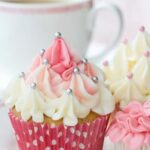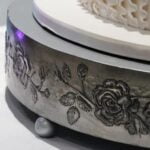Cake Decorations play a significant role in transforming ordinary cakes into extraordinary works of art that enhance the overall experience of any celebration. From birthdays to weddings, anniversaries to graduations, cake decorations add that perfect finishing touch, setting the tone and creating lasting memories for both the host and the guests.
The art of cake decorating has a rich history that dates back centuries. Over time, it has evolved from simple adornments to intricate designs that require skill, creativity, and a wide range of specialized tools and supplies. Whether it’s using fondant to create stunning sculptural elements or mastering the delicate technique of piping with buttercream or royal icing, cake decorators have pushed the boundaries of imagination to bring their creations to life.
In this article, we will explore the world of cake decorations – from its fascinating history to essential tools and supplies needed for this craft. We will delve into various techniques such as fondant modeling, buttercream piping, and royal icing detailing.
Additionally, we will discuss popular decoration ideas for different occasions and walk you through step-by-step tutorials on achieving professional-looking cake decorations at home. Moreover incorporate troubleshooting tips for common issues that arise during the decoration process along with ways to create custom decorations using edible prints and cutters.
Furthermore, we will reveal some of the latest trends sweeping through cake decorating community – from drip cakes oozing with vibrant colors and flavors to geode-inspired designs that showcase stunning crystalline patterns found in nature. Unleashing your creativity is key when it comes to adding that extra dose of magic to every cake you make.
So whether you’re a professional baker or someone who enjoys baking as a hobby, join us on this journey as we dive into the world of cake decorations. Let us equip you with the knowledge and skills needed to transform your cakes into showstopping masterpieces that will leave your guests speechless. Get ready to unlock your creativity and discover endless possibilities in achieving memorable cake decorations that will make every celebration truly exceptional.
The Art of Cake Decorating
The art of cake decorating has a long and fascinating history that spans across centuries and cultures. From simple designs to intricate masterpieces, cake decorations have evolved into an art form that adds beauty and creativity to our celebrations. In this section, we will delve into the rich history of cake decorating and explore how it has evolved over time.
Cake decorating can be traced back as far as ancient Egypt, where evidence of intricate cake designs on tomb walls have been found. In medieval Europe, cakes were often used as centerpieces for celebrations such as weddings and birthdays. These cakes were elaborately decorated with sugar sculptures, marzipan fruits, and edible gold leaf. During the Renaissance period, the first icing recipes emerged, allowing for more elaborate designs on cakes.
In the 19th century, the industrial revolution brought about advancements in cake decorating tools and techniques. With the invention of baking powder and better ovens, cakes became lighter and fluffier, making them easier to decorate. The introduction of piping bags and tips allowed for more precise designs, while stencils made it easier to create intricate patterns.
Today, cake decorating has become a true art form with professional decorators creating stunning works of edible art. From beautifully sculpted fondant figures to hand-painted designs, there are endless possibilities when it comes to adorning a cake. This rich history of cake decorating reminds us of its importance in our celebrations and highlights the creativity and skill required to create these stunning confections.
A Brief History: Key Milestones in Cake Decorating
| Time Period | Key Milestones |
|---|---|
| Ancient Egypt | Evidence of intricate cake designs on tomb walls. |
| Medieval Europe | Elaborate cake decorations with sugar sculptures and marzipan fruits. |
| Renaissance period | Introduction of icing recipes, allowing for more elaborate designs. |
| 19th century | Invention of piping bags, tips, and stencils for more precise designs. |
As we can see, cake decorating has come a long way since its humble beginnings. Today, it is not only a skill but an art form that allows people to express their creativity and add that perfect finishing touch to every celebration. Whether it’s a simple birthday cake or an extravagant wedding cake, the art of cake decorating continues to evolve and captivate us with its beauty and innovation.
Essential Tools and Supplies for Cake Decorations
Cake decoration is an art that requires the right tools and supplies to achieve beautiful and professional-looking designs. Whether you are a beginner or an experienced decorator, having the essential tools and supplies at your disposal is crucial for creating stunning cake decorations. From icing bags to piping tips, these tools are a necessity in any cake decorator’s toolkit.
One of the most important tools for cake decoration is the icing bag. This tool allows decorators to easily pipe different designs onto cakes and cupcakes. Icing bags come in various sizes, materials, and designs, giving decorators a range of options to choose from based on their preferences. Couplers are also necessary for attaching different piping tips to the icing bag, allowing decorators to easily switch between designs without having to change the entire bag.
Piping tips are another essential tool for cake decoration. These small metal nozzles come in a wide array of shapes and sizes, each creating a unique pattern when used with an icing bag.
Some popular types of piping tips include round tips for writing and outlining, star tips for creating rosettes and borders, leaf tips for adding foliage details, and petal tips for making realistic flower decorations. Having a variety of piping tips enables decorators to experiment with different designs and create intricate patterns on their cakes.
In addition to icing bags and piping tips, other essential supplies for cake decoration include offset spatulas for smoothing frosting, cake turntables for easy rotating while decorating, stencils for creating precise patterns and designs, and fondant smoothers for achieving a polished finish on fondant-covered cakes. These supplies make the process of cake decoration more efficient and help decorators achieve professional-looking results.
Having access to high-quality tools and supplies is vital in the world of cake decoration. By investing in these essentials like icing bags, piping tips, offset spatulas, stencils, and fondant smoothers, decorators can unlock their creativity and bring their cake decorating skills to the next level. With the right tools in hand, decorators can create beautiful and memorable cake decorations for any occasion.
| Essential Tools | Supplies |
|---|---|
| Icing Bags | Offset Spatulas |
| Piping Tips | Cake Turntables |
| Stencil | Fondant Smoothers |
Exploring Different Types of Cake Decorations
Cake decorations come in various forms and techniques, giving bakers the opportunity to unleash their creativity and add a personal touch to their cakes. In this section, we will explore some of the most popular types of cake decorations, including fondant, buttercream, royal icing, and more.
Fondant
Fondant is a smooth, pliable icing that can be rolled out and draped over cakes for a flawless finish. It is made from sugar, water, and gelatin or agar-agar. Fondant provides a clean canvas for intricate designs and allows for limitless creativity. It can be colored using food coloring gels or dusted with edible shimmer for an added sparkle.
Buttercream
Buttercream is a rich and creamy frosting made from butter, powdered sugar, and flavorings such as vanilla or chocolate. It can be easily piped onto cakes using various tips to create different patterns or designs. Buttercream can also be dyed with food coloring to achieve vibrant colors. Its creamy texture makes it perfect for creating smooth finishes or adding texture with spatulas or combs.
Royal Icing
Royal icing is a sweet icing made from egg whites or meringue powder, powdered sugar, and lemon juice or cream of tartar. It dries hard and is often used for intricate details like lacework or delicate flowers on cakes. Royal icing can also be used for piping borders or writing messages on cakes. It can be tinted with food coloring for different shades.
In addition to these popular cake decorating mediums, there are many other options available such as ganache (a mixture of chocolate and cream), marzipan (an almond-based paste), whipped cream, and even fresh fruits or flowers for natural decorations. Each type of decoration has its own unique properties and techniques that contribute to the overall appearance of the cake.
Top 10 Cake Decoration Ideas for Every Occasion
Cake decorations play a crucial role in making every celebration special and memorable. Whether it’s a birthday, wedding, anniversary, or any other occasion, the right cake decoration can transform a simple dessert into a stunning centerpiece. In this section, we will explore the top 10 cake decoration ideas that are perfect for every occasion.
- Floral Delight: Adorn your cake with beautiful and lifelike sugar flowers. Choose flowers that match the theme or color scheme of the event for an elegant touch.
- Drip Cakes: This trendy decoration involves pouring drips of ganache or colored icing over the edges of the cake to create a stunning cascading effect. It adds a modern and artistic flair to any occasion.
- Buttercream Ruffles: Create delicate and romantic ruffles using buttercream icing. These soft and textured designs give a whimsical and feminine touch to cakes.
- Edible Pearls: Give your cake a touch of sophistication by adding edible pearls around the edges or as accents throughout the design. They create an elegant and classic look suitable for weddings and anniversaries.
- Ombré Effect: Achieve a gradient color effect on your cake by blending shades from light to dark or vice versa. This visually striking technique adds depth and dimension to any celebration.
- Fondant Cutouts: Use fondant cutters to create intricate shapes like hearts, stars, or even personalized initials to showcase creativity on special occasions.
- Metallic Accents: Add a touch of glamour to your cake with metallic accents like gold or silver leaf toppings, edible glitter, or metallic-dusted decorations.
- Geometric Patterns: Incorporate geometric patterns such as chevrons, stripes, or hexagons onto your cake design for a modern and contemporary look suitable for birthdays or milestone celebrations.
- Watercolor Effect: Create an artistic masterpiece by applying streaks of food coloring mixed with alcohol or water on the cake surface. This technique mimics the delicate strokes of a watercolor painting and adds a unique touch to any occasion.
- Novelty Cakes: Surprise and delight your loved ones with a custom-made novelty cake that reflects their interests or hobbies. From sports-themed cakes to replicas of favorite characters, these cakes are sure to be the highlight of any celebration.
These top 10 cake decoration ideas are just a starting point for unleashing your creativity. Remember to personalize each design based on the occasion and the recipient’s preferences. By adding that perfect finishing touch, you can create a cake that not only looks stunning but also leaves a lasting impression on everyone’s taste buds.
Step-by-Step Tutorial
Decorating a cake can seem like an intimidating task, but with the right techniques and a little practice, anyone can achieve professional-looking cake decorations at home. Whether you’re looking to impress your guests at a special occasion or simply want to indulge in some creative baking, this step-by-step tutorial will guide you through the process.
Step 1: Preparing Your Cake
Before you begin decorating, it’s important to have a well-prepared cake. Start by leveling the top of the cake using a serrated knife or cake leveler. This will ensure an even surface for decorating. Next, apply a thin layer of frosting as a crumb coat and refrigerate for about 15 minutes to firm up the frosting.
Step 2: Choosing Your Icing
The type of icing you choose will depend on your desired design and personal preference. Buttercream is a popular choice due to its versatility and smooth texture. It can be easily tinted with food coloring and is perfect for adding borders, flowers, and designs. Fondant is another option that gives cakes a sleek and polished appearance. It can be rolled out and draped over the cake for a flawless finish.
Step 3: Piping Techniques
Piping is one of the most valuable skills in cake decorating. To pipe intricate designs, you’ll need piping bags and tips. Fill your piping bag with icing, ensuring not to overfill it as it may become difficult to control the flow of icing. Hold the bag firmly with one hand while guiding the tip with your other hand to create smooth lines, borders, or decorative shapes on your cake.
Step 4: Adding Decorative Elements
Once you have piped your desired designs onto the cake, it’s time to add decorative elements such as sugar flowers, sprinkles, or edible pearls. These details will enhance the overall look of your cake and make it more visually appealing. Carefully place these elements on your cake, ensuring they adhere to the frosting or fondant.
Remember, practice makes perfect when it comes to cake decorating. Don’t be discouraged if your first attempts aren’t flawless – with time and patience, you’ll develop confidence in your skills and create stunning cakes that will impress both yourself and others. So go ahead, unleash your creativity and enjoy the process of decorating beautiful cakes at home.
Troubleshooting Common Cake Decoration Issues
Cake decorating can be a fun and rewarding experience, but it is not without its challenges. In this section, we will explore some common issues that cake decorators may encounter and provide troubleshooting tips to help you overcome them.
One common problem in cake decoration is the occurrence of cracks on the surface of the cake. This can happen due to several reasons, such as over-baking or uneven cooling. To prevent cracks, make sure to properly grease and flour your pans before pouring in the batter. Additionally, avoid overmixing the batter and bake the cake at the recommended temperature for the specified time.
If cracks do occur, there are a few ways to salvage the appearance of your cake. One option is to create a filling or frosting that will cover up the cracks. For example, a thick layer of buttercream icing can help hide any imperfections. Another option is to use decorations strategically placed over the cracks, such as flowers or other edible embellishments.
Another issue that often arises in cake decoration is smudging or smearing of icing or frosting. This can happen when working with delicate designs or intricate details. To prevent smudging, it is important to let each layer of icing dry completely before adding another layer or working on top of it. You can also try refrigerating the cake for a short period of time between adding layers of icing to help set it.
In some cases, despite your best efforts, certain challenges may still arise during cake decoration. However, don’t be discouraged. Remember that practice makes perfect and every mistake is an opportunity to learn and improve your skills. With patience and persistence, you will be able to troubleshoot any issues you encounter and create beautiful cakes that leave a lasting impression.
- Properly grease and flour pans before pouring in batter
- Avoid overmixing batter
- Bake at recommended temperature for specified time
- Create a filling or frosting to cover up cracks
- Strategically place decorations over cracks
- Let each layer of icing dry completely before adding another layer or working on top of it
- Refrigerate the cake for a short period of time to help set icing
- Practice and learn from mistakes to improve skills
Do-It-Yourself
Creating custom cake decorations is a popular trend that allows bakers to add a personalized touch to their cakes. One way to achieve this is by using edible prints and cutters. These tools can transform a simple cake into a masterpiece, showcasing intricate designs, personal photographs, or themed elements.
Edible Prints
Edible prints are essentially edible images that can be placed on top of a cake or other sweet treats. They are made using food-grade ink and specially designed printers. Here’s how you can create custom cake decorations with edible prints:
- Choose your design: Start by selecting the image or design you want to use as your cake decoration. It can be anything from a photograph of the birthday celebrant to a favorite cartoon character.
- Print on edible paper: Once you have chosen your design, print it onto an edible paper sheet using an edible ink printer. You can find these printers and compatible sheets at specialty baking stores or online.
- Prepare your cake: Before placing the edible print on your cake, make sure the surface is clean and dry. You may also want to apply a thin layer of icing or fondant to help the print adhere better.
- Apply the print: Carefully peel off the backing from the edible print and gently lay it onto the desired area of your cake. Smooth out any air bubbles or wrinkles using a clean, dry finger or a smoother tool.
Edible Cutters
Another method for creating custom cake decorations is by using edible cutters. Edible cutters come in various shapes and sizes and allow you to cut out different designs from rolled fondant, gum paste, or modeling chocolate. Here’s how you can make use of them:
- Roll out your medium: Start by rolling out your chosen edible medium, such as fondant or gum paste, to an even thickness. Make sure it’s not too thin, as it may tear when using the cutter.
- Choose your cutter: Select the edible cutter that matches the design you want to create. There are endless options available, from flowers and shapes to letters and numbers.
- Press and cut: Place the chosen cutter onto the rolled-out medium and press down firmly but gently. Wiggle it slightly to release the design from the excess medium.
- Apply to your cake: Once you have cut out your desired shape, carefully lift it up and place it onto your cake. You can secure it in place using a small amount of water or edible glue.
By incorporating edible prints and cutters into your cake decorating repertoire, you can easily personalize cakes for any occasion. Whether it’s a favorite superhero for a birthday party or an elegant monogram for a wedding cake, these DIY techniques will allow you to create stunning and unique cake decorations that will surely impress everyone at the celebration.
The Latest Trends in Cake Decorations
As the world of cake decorations continues to evolve, new trends constantly emerge to captivate bakers and party-goers alike. From extravagant drip cakes to mesmerizing geode designs, these latest trends allow for a stunning and unique touch to be added to any special occasion. Here, we will explore the newest trends in cake decorations that are sure to impress.
One of the most popular trends in cake decorations today is the drip cake. This technique involves pouring or drizzling a liquid or semi-liquid substance, such as ganache or caramel sauce, over the top of the cake so that it drips down the sides. The result is a visually striking effect that adds depth and texture to any design. Drip cakes can be customized with various colors and flavors, making them suitable for any theme or occasion.
Another trend that has taken the cake decorating world by storm is geode designs. Inspired by the natural beauty of crystals and gemstones, geode cakes feature intricate sugar work that replicates the patterns and textures found in rocks and minerals. This technique involves using fondant or sugar paste to create realistic-looking geodes on the surface of the cake. Edible metallic paints are often used to add shimmer and sparkle to these magnificent creations.
In addition to drip cakes and geode designs, other popular trends in cake decorations include watercolor effects, painted floral motifs, naked cakes (with minimal frosting on display), and gravity-defying structures. These trends not only showcase artistic talent but also provide endless opportunities for customization based on personal preferences and event themes.
By staying up-to-date with these latest trends in cake decorations, both professional bakers and home enthusiasts can elevate their creations from ordinary to extraordinary. Whether you choose to experiment with drip cakes or attempt a geode design masterpiece, incorporating these trendy techniques into your repertoire is an excellent way to keep your cakes fresh, exciting, and memorable for every celebration.
Conclusion
Cake decorations are an essential part of creating memorable celebrations. They not only add a visually appealing element to the cake but also reflect the theme and purpose of the occasion. Throughout history, cake decorating has evolved into an art form, with different techniques and styles being developed.
To achieve professional-looking cake decorations at home, it is important to have the right tools and supplies. From icing bags to piping tips, these tools help in creating intricate designs and adding texture to the cake. Different types of decorations such as fondant, buttercream, and royal icing offer a variety of options for creativity.
For those who want to personalize their cakes further, custom cake decorations can be created using edible prints and cutters. This allows individuals to add a personal touch or incorporate specific designs that match the theme of the celebration. Additionally, staying updated with the latest trends in cake decorations such as drip cakes or geode designs can provide inspiration for unique creations.
In conclusion, cake decorations are an integral part of any celebration. By unleashing your creativity and paying attention to detail when adding that perfect finishing touch to every cake, you can create memorable experiences for both yourself and your guests. Whether it’s a birthday, wedding, anniversary, or any other occasion, investing time and effort into cake decorating will make the event even more special.

Welcome to my blog about home and family. This blog is a place where I will share my thoughts, ideas, and experiences related to these important topics. I am a stay-at-home mom with two young children. I hope you enjoy reading it! and may find some helpful tips and ideas that will make your home and family life even better!





